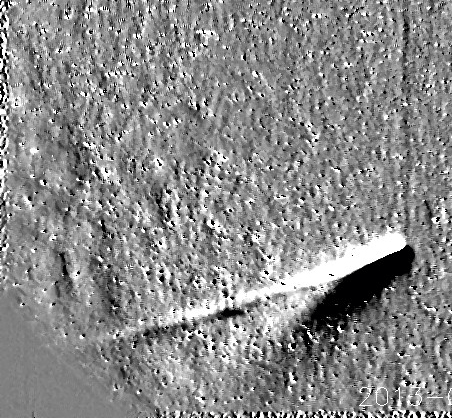An icy interloper was in the sights of a NASA spacecraft this past weekend.
Comet 2012 F6 Lemmon passed through the field of view of NASA’s HI2A camera as seen from its solar observing STEREO Ahead spacecraft. As seen in the animation above put together by Robert Kaufman, Comet Lemmon is now displaying a fine ion and dust tail as it sweeps back out of the inner solar system on its 10,750 year plus orbit.
Comet Lemmon has been a dependable performer for southern hemisphere observers early in 2013. As we reported earlier this month for Universe Today, this comet is now becoming a binocular object low in the dawn sky for northern hemisphere astronomers.
Comet Lemmon passed perihelion at 0.73 astronomical units from the Sun on March 24th. It’s currently in the +4th to +5 magnitude range as it heads northward through the constellation Pisces.
NASA’s twin Solar TErrestrial RElations Observatory (STEREO) spacecraft often catch sungrazing comets as they observe the Sun. Known as STEREO A (Ahead) & STEREO B (Behind), these observatories are positioned in Earth leading and trailing orbits. This provides researchers with full 360 degree coverage of the Sun. Launched in 2006, STEREO also gives us a unique perspective to spy incoming sungrazing comets. Recently, STEREO also caught Comet 2011 L4 PanSTARRS and the Earth as the pair slid into view.
Another solar observing spacecraft, the European Space Agencies’ SOlar Heliospheric Observatory (SOHO) has been a prolific comet discoverer. Amateur comet sleuths often catch new Kreutz group sungrazers in the act. Thus far, SOHO has discovered over 2400 comets since its launch in 1995. SOHO won’t see PanSTARRS or Lemmon in its LASCO C3 camera but will catch a glimpse of Comet 2012 S1 ISON as it nears the Sun late this coming November.
Like SOHO and NASA’s Solar Dynamics Observatory, data from the twin STEREO spacecraft is available for daily perusal on their website. We first saw this past weekend’s animation of Comet Lemmon passing through STEREO’s field of view on the Yahoo STEREOHunters message board.
Here’s a cool but largely unrecognized fact about comets. As they move back out of the solar system, their dust tail streams out ahead of them, driven by the solar wind. I’ve even seen a few science fiction flicks get this wrong. We simply expect comets to always stream their tails out behind them!
Another observatory in our solar observing arsenal has also moved a little closer to operability recently. The Interface Region Imaging Spectrograph (IRIS) arrived at Vandenberg recently in preparation for launch this summer on June 26th. IRIS will be deployed from a Pegasus XL rocket carried aloft by an L-1011. NuSTAR was launched in a similar fashion in 2012. A Pegasus XL rocket will also launch the TESS exoplanet hunting satellite in 2017.
Keep an eye out for Comet Lemmon as it emerges from the dawn twilight in the days ahead. Also, be sure to post those pics to Universe Today’s Flickr community, and keep tabs on the sungrazing action provided to us by SOHO and STEREO!


Wow! This is GREAT! To know technology will be even better as each year passes. The mind of a human being is endless. …PEACE!
delete